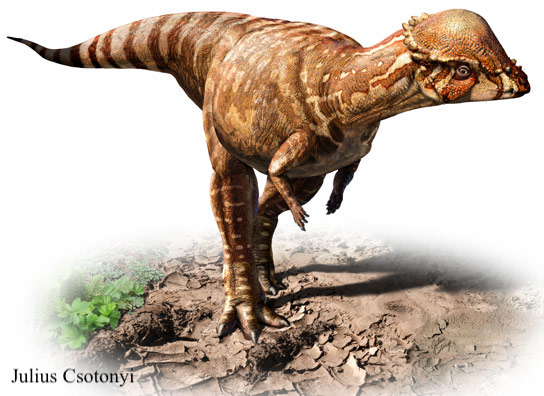Welcome to Acrotholus

Name Definition
High dome
Name Given By
Evans et al., 2013
Location
Milk River Formation of Alberta, Canada
Classification
Dinosauria, Ornithischia, Cerapoda, Marginocephalia, Pachycephalosauridae
Size
around 1.6 feet tall (0.5 meters), 5.9 meters long (1.8 meters long), 39 kg (88 lbs)
Temporal Range
Santonian stage of the late Cretaceous, 84 - 83.5 million years ago
Ecological niche
small bipedal herbivore, most likely a browser (an animal that feeds on plant leaves and fruits)
Species/Sub Species
A. audeti
Diet
Similar to most other pachycephalosaurids, Acrotholus was more adapted to consuming lower plants at about a height of 1 meter
Introduction
Acrotholus is a genus of pachycephalosaurid dinosaurs that lived in Canada during the late Cretaceous. The name Acrotholus means “high dome” which is a reference to its thick and dome shaped head, something typical in pachycephalosaurids. The species name audeti honors Roy Audet, the rancher who owned the land that the holotype was originally discovered on in 2008. Even though the genus is only represented by a few skull fragments, Acrotholus is still a pretty special find. At the time of its discovery, Acrotholus was the oldest valid genus of pachycephalosaur to come from North America. Another important factor of its discovery is the fact that Acrotholus also had a completely developed head dome. The most probable and more popular theory for the purpose of this dome is for intra-species combat. This is backed up by the fact that there have been lesions found on the skulls with signs of healing suggesting that they survived after the impact. Basically, two pachycephalosaurids would come charging at each other head on until they bash into each other, with their thick domes helping aid in protection against damage caused by the force of the impact. The dome of Acrotholus is known to have a maximum thickness of 55 millimeters above the cerebral fossa. The team that discovered and described Acrotholus also took the opportunity to point out that in the fossil record there seems to be some sort of bias when it comes to the preservation of an animal depending on its size. Larger animals like sauropods have proportionately larger bones which means that it is harder for carrion feeders to consume them because of common factors like not having a large enough mouth or a weak bite force that is not strong enough to break the bones. Smaller animals on the other hand have smaller bones which means a majority of the carnivores living with the small animal are able to consume its bones, hence there are less bones of smaller animals to be fossilized. The most well preserved animals that were relatively small were usually discovered well-preserved due to factors like being buried in a landslide or being buried in sediment at the bottom of a body of water. Another find in 2013, Albertadromeus, further supports this theory, with only partial postcranial remains of Albertadromeus being discovered. While Acrotholus is definitely the oldest American pachycephalosaur, it isn’t as old as some of the Asian genera like Amtocephale, but it does help scientists visualize the paleofauna of North America earlier in the late Cretaceous epoch. Since scientists now know about this, Acrotholus may be one of many other Santonian age pachycephalosaurs that have yet to be discovered. Discovered in the Milk River Formation, Acrotholus would have been hunted by smaller predators like Paronychodon and Saurornitholestes, but also lived with animals like the dubious ankylosaur Paleoscincus, the hadrosaur Kritosaurus, and other genera of dinosaurs, reptiles, and mammals.